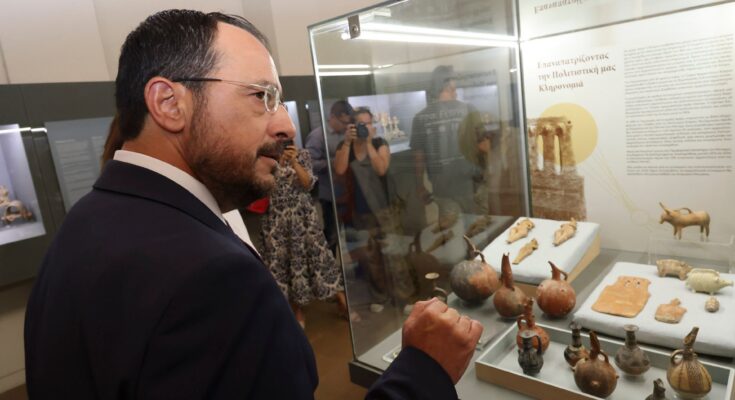Cyprus exhibited recovered artifacts, some thousands of years old, that were looted by a Turkish art dealer, after the invasion of 1974.
Aydin Dikmen stole the artifacts when Turkey invaded. The antiquities were kept in Germany after authorities there seized them in 1997, and protracted legal battles secured their repatriation in three batches, the last one this year.
Among the 60 most recently returned artifacts put on display include jewelry from the Chalcolithic Period between 3500-1500 BC and Bronze Age bird-shaped idols.

Antiquities that Dikmen also looted but were returned years ago include 1,500-year-old mosaics of Saints Luke, Mark, Matthew and James. They are among the few examples of early Christian works that survived the Iconoclastic period in the 8th and 9th centuries when most such works were destroyed.

Dikmen, aided by the occupation regime and accomplices, was responsible for the removal of over 50 Greek Orthodox, Maronite and Armenian Christian monuments, as well as antiquities from occupied archaeological sites and private collections.
The legal battle began in 2004 and saw its resolution in 2010 with the decision of the Munich District Court. However, Dikmen’s subsequent appeal to the Court of Appeal led to the partial repatriation of 173 relics in July 2013 and another 85 in August 2015.
The final act of the Dikmen case unfolded with the signing of the repatriation agreement and the restoration of cultural heritage to its rightful place.
Among the thousands of objects seized from Dikmen’s antiquities smuggling operation in March 1997 were 318 relics of Cypriot origin, including mosaics from the 6th century, frescoes spanning the 8th to 15th centuries, icons, doors, manuscripts and various prehistoric artifacts.

Looted artifacts “an open wound of the Turkish invasion of Cyprus”
Addressing the unveiling ceremony at Cyprus’ archaeological museum, President Nikos Christodoulides said the destruction of a country’s cultural heritage as evidenced in recent conflicts becomes a “deliberate campaign of cultural and religious cleansing that aims to eliminate identity.”
He said that this “is one of the most tragic open wounds of the Turkish invasion and continued occupation. Hundreds of churches and archaeological sites have been looted and tens of thousands of church relics and ancient objects have been extracted.”
The museum’s antiquities curator, Eftychia Zachariou, told the ceremony that Cyprus in recent years has benefited from a shift in thinking among authorities in many countries who now opt to repatriate antiquities of dubious provenance.
According to the Director of the Office for Combating Illegal Possession and Trafficking of Antiquities Michalis Gavrielidis, over 16,000 Christian icons, mosaics and murals dating from to 6th and 5th centuries have been forcibly stolen and sold abroad since the Turkish invasion in 1974.
Related: Turkish Occupation Continues to Erase Ancient Heritage of Cyprus



